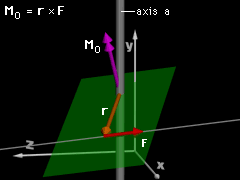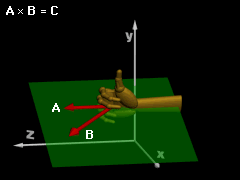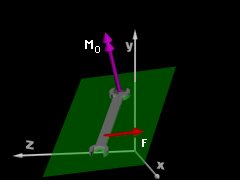| Ch 4. Moments/Equivalent Systems | Multimedia Engineering Statics | ||||||
|
Moment 2-D Scalar |
Moment 3-D Scalar |
Moment 3-D Vector |
Couples and Equiv. System | Distributed Loads, Intro | |||
| Moment of Force: 3-D Vector | Case Intro | Theory | Case Solution |
| Chapter |
| 1. Basics |
| 2. Vectors |
| 3. Forces |
| 4. Moments |
| 5. Rigid Bodies |
| 6. Structures |
| 7. Centroids/Inertia |
| 8. Internal Loads |
| 9. Friction |
| 10. Work & Energy |
| Appendix |
| Basic Math |
| Units |
| Sections |
| eBooks |
| Dynamics |
| Fluids |
| Math |
| Mechanics |
| Statics |
| Thermodynamics |
| ©Kurt Gramoll |
|
|
||
| The Cross Product |
||
|
|
The dot product was previously introduced as a way of "multiplying" vectors where the result is a scalar, A • B = AB cosθ The second method for "multiplying" vectors is called the cross product, and the result is a vector. The cross product of two vectors A and B gives the vector C that has a magnitude of |C| = |A × B| = AB sinθ Here θ is the angle between the vectors A and B. The vector C is perpendicular to the plane defined by the vectors A and B, and the direction is determined from the right-hand rule. |
|
| Cross Product with Cartesian Vectors |
||
|
If the vectors A and B are in Cartesian form, then it can be shown that the cross product of A and B is given by the determinant of the unit vectors and the Cartesian components of A and B. It is interesting to note that this determinant could also be written as, The results will be the same for either form. |
||
 Vectors r and F are always perpendicular to M ( = r × F)
|
Moment as a Cross Product |
|
|
If the moment of a force F about the point O is represented by the vector Mo, then it can be shown that Mo = r × F Here r is the position vector of any point on the line of action of F with respect to point O. Expanding the determinant form of the cross product, gives Mo = (ry Fz
- rz Fy)i + (rz Fx
- rx Fz)j From this equation, the Cartesian components of the moment vector Mo
are readily found. |
||
| Moment of a Force About a Line or Axis |
||
 Moment About an Axis |
In many problems, it is necessary to determine the moment of a force about a certain line or axis, such as an axle on a car. Since the moment of a force is a vector, the dot product can be used to determine its component parallel to any line a. Ma = (Mo
• ua) ua Here ua is the unit vector in either direction of the line a. |
|
Practice Homework and Test problems now available in the 'Eng Statics' mobile app
Includes over 500 free problems with complete detailed solutions.
Available at the Google Play Store and Apple App Store.



